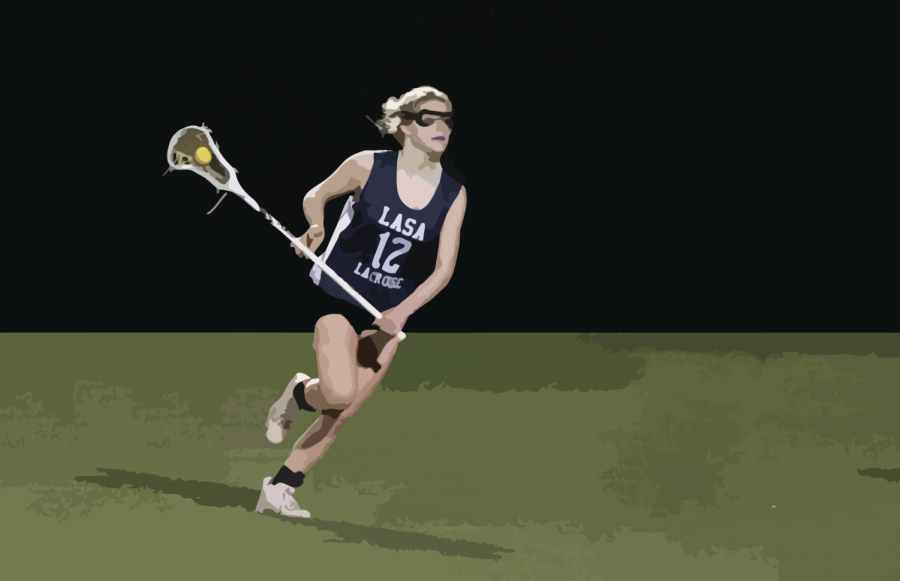Lacrosse Keeps Their Eye on the Ball
May 15, 2023
The LASA girl’s lacrosse team is one of the two non-UIL sports at LASA but maintains a size of 20 players and two coaches. As a result of being a non-UIL sport, the team does not receive funding from the Austin Independent School District (AISD) or the benefits that a UIL-sponsored sport normally would, which includes reserved field time and physical education (P.E.) credit. Lacking the benefits a UIL sport receives effectively gives the team the status of a club instead of a true sports team, although the team practices two or three times a week and plays games regularly, just like a typical LASA sports team.
Senior Kyra Kleiman has been a part of the LASA lacrosse team since she started playing as a freshman. Kleiman enjoys some of the physical peculiarities of the sport, such as cradling. Cradling is when the player, holding the ball in their stick, rapidly moves the stick in half-rotations, using centrifugal motion in order to keep the ball from falling out while staying primed for accurate throwing. Although Kleiman had never played lacrosse before playing at LASA, she decided to join when her friend asked her to carry her lacrosse stick for her.
“It was really random,” Kleiman said. “I was walking with my friend and I grabbed her stick, and I was like, ‘Oh, this is cool.’ I had a couple of friends on the team, so I just decided to join.”
According to Kleiman, one of the many challenges that comes with not being sponsored by UIL is the lack of field space. Due to multiple sports using the same practice field, Kleiman said it can be difficult to find a designated practice spot.
“The main thing is that we don’t have an assigned portion of the field,” Kleiman said. “There wasn’t a lot of space because soccer was playing, so we’d have to practice on a tiny part of the field. Right now we just practice behind the tennis courts because that’s where no one else is.”
Being an unofficial sport makes lacrosse more student-run, according to Kleiman. She remains committed to lacrosse due to the close relationships she has with her team members.
“I was always committed to just learning and getting to play with my friends,” Kleiman said. “It’s definitely a different feel because it doesn’t feel super official sometimes. [But], it’s just a fun environment to be with the people that were like all friends together.”
Vivian Butler, a senior and another member of the lacrosse team, has been playing since she was in middle school. However, Butler didn’t know that LASA had a girls’ lacrosse program until she stumbled upon an announcement by chance during her freshman year.
“I didn’t know much about the lacrosse program since it wasn’t publicized or on the course schedule,” Butler said. “I saw a random poster in the hallway, and I knew I wanted to join.”
Although Butler was excited to join the lacrosse team, she was less than enthused to face the reality of the sport not being a part of UIL. She had been counting on lacrosse to give her a P.E. credit during her senior year but later found out that it wasn’t possible.
“It has been really tough,” Butler said. “I waited to get my credits until [senior] year, so I think it’s unfair that lacrosse isn’t counted as a UIL sport. It has just made it really hard to balance two sports since I have to do two extra credits.”
Ellyce Davis, a senior on the lacrosse team, has been playing since seventh grade, when she went to Kealing Middle School. Since she was already familiar with lacrosse before she enrolled in high school and her friends also played, it was an easy choice for her to join the team. Like Butler, Davis agrees that the lack of UIL support has made her high school lacrosse experience more difficult.
“[The lack of recognition by UIL] definitely made it harder to play because we don’t get funding or anything like that,” Davis said. “It’s not a P.E. credit, so we have girls who still need to get a P.E. credit outside of lacrosse as well, which made it harder to convince people to join.”
Davis also listed the absence of pay for coaches as a challenge for the logistics of the team. According to Davis, it was hard to find a coach for lacrosse since it was not officially recognized.
“It was harder to find someone to coach the sport because teachers get paid to coach UIL sports, but they don’t get paid to coach club sports, so we had to find coaches elsewhere,” Davis said. “It’s a little bit different from UIL, and it makes it more of a hassle to find people who are willing to [coach lacrosse].”
However, Butler believes that these challenges have resulted in a more cohesive team identity. According to Butler, overcoming these challenges together has brought the team closer.
“I think the teamwork factor is the biggest part,” Butler said. “Since we are not getting credit for being there, we are all super close and passionate about the sport itself, not where it gets us.”


